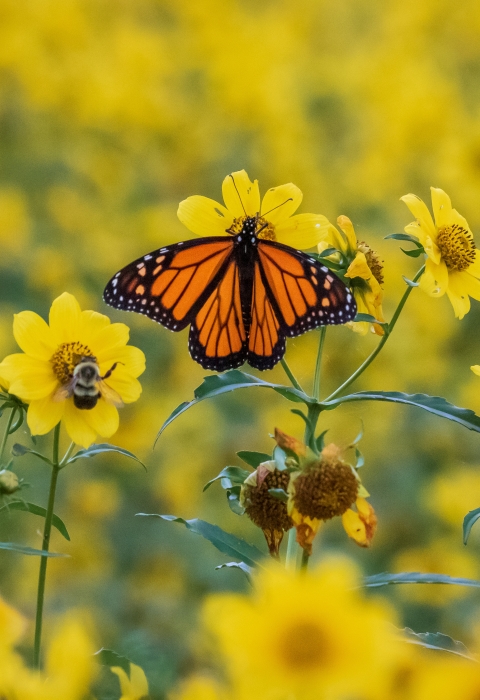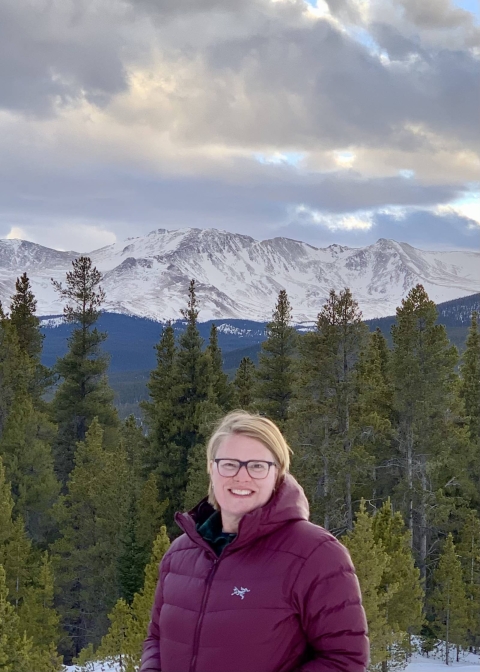We at the U.S. Fish and Wildlife Service strive to work with others to make our world better for wildlife and people. Our work also involves having the right people, and Nicole Alt will lead our efforts for pollinators as the first director of the Center for Pollinator Conservation. The center was created in December 2022 to address declining pollinator populations in North America. Take a moment to meet Nicole Alt and learn about her vision for leading the center as well as what the center is doing to improve pollinator populations.
Nicole Alt grew up in eastern Iowa, exploring and enjoying being outside. A small family farm provided many adventures, and her grandfather always made new discoveries – a fox den, finding milkweed patches, or a bird nest with eggs. These small adventures and her grandfather’s words, “if you take care of the land, it will provide for you,” helped build a curiosity and foundation for the love of nature, especially in the prairie.
With more than 20 years in the U.S. Fish and Wildlife Service, Alt began her career at headquarters in Washington, D.C. with congressional and legislative affairs, then the Director’s Office and Ecological Services. Representing the agency within the Department of the Interior and with Congress offered a broad view of operations, policies, litigation and every program in the agency. After serving at the national level, Alt moved west to the Mountain-Prairie Region as deputy assistant regional director for Ecological Services. Then she then became a field supervisor at the Colorado Ecological Service Field Office.
In her new role, Alt continues to call the Mountain-Prairie Region home. Being co-located in Fort Collins, Colorado, with the Natural Resources Conservation Program, will offer Alt an opportunity to leverage the center’s function as a national network to support and inform conservation decisions across the agency’s programs and regions.
“Conservation is always about people, building relationships, and supporting others,” said Alt. “I strive to build trust and relationships by listening, understanding perspectives, and finding common ground to improve conservation success.”
Alt’s successful coaching leadership style stems from her time on the farm, a competitive swimming career, and learning from those who walked before her. She is grateful for the support and opportunities that have helped her grow and take on large-scale challenges like creating an inclusive workplace culture, transforming the Endangered Species Act listing program and building a coalition to support conservation measures for greater sage-grouse habitat. She will take the lessons from these experiences to help define the agency’s voice and role for the Center for Pollinator Conservation. Alt looks forward to listening and working with others to promote pollinator conservation.
Update on the Center for Pollinator Conservation
Like soil, pollinators are a key component for a healthy ecosystem. While they may be small and easy to miss, they make up a large, diverse group of organisms that play an integral part in the whole system. The Center for Pollinator Conservation staff is keenly aware of this connection and uses it to identify projects that will benefit pollinators the most. Here are a few projects highlighted from the center.
To leverage conservation efforts, the center is expanding pollinator inventory and monitoring efforts on national wildlife refuges. Partnering with Monarch Joint Venture, we’ll be using uncrewed aircraft systems and artificial intelligence to rapidly census the distribution of milkweed on several refuges. This unique partnership is pioneering a new approach for censusing common milkweed, an essential host plant of monarchs. The hope is to expand this type of technology to other future survey needs across public lands managed by the U.S. Fish and Wildlife Service.
The center continues to advance the conservation of at-risk native pollinators by contributing funds to the National Fish and Wildlife Foundation’s Monarch Butterfly and Pollinators Conservation Fund. The Pollinator Fund is reviewing proposals to award up to $2.7 million in grants for the 2023 grant cycle. Since 2015, the fund has awarded $19.7 million to 123 projects that are helping conserve and recover the monarch butterfly while also benefiting other native pollinator species.
Building on the enduring work for monarch butterflies with the Commission for Environmental Cooperation, an international organization collectively established by Canada, Mexico and the United States, the center is part of a two-year project focusing on native bees throughout North America. This project promotes sharing lessons learned, best practices and strategies to inform native bee inventorying and monitoring in the three countries.
The center’s effort and investment for pollinators will continue to grow as the center evolves. It is a place for land managers, decision and policy makers, scientists, program leaders and others to explore, coordinate and share best practices and approaches to proactively addressing the decline in native pollinator populations.





